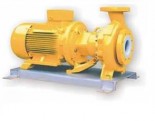Techniflo Mag Drive Pumps Solve the Maintenance Problems of Smelter Refinery:
Copper is one of the most highly sort after minerals in Australia. There are various methods of extracting copper from the mineral ore. The traditional method involves breaking and crushing the ore and then finely grinding it along with a floatation process. This initial concentrate contains anywhere from 25 to 57% copper and is sent to the smelter for further processing.
Smelting converts the concentrate into the copper metal. This involves melting the concentrate with fluxes in a smelter furnace to produce copper matte, which is the mixture of iron and copper sulphides along with other impurities, containing up to 70% copper. The molten matte is then sent to a converter where more fluxes are added to form blister copper which is 98 to 99% pure. Blister copper is further refined by the electrolysis processes. Smelting involves increasing the amount of copper in the concentrate, which is then eventually obtained in a pure form in the last process.
The concentrate that comes to the smelter contains a number of impurities and particles which has to be pumped in order to transport it from one process to the other. Typically the pumps used are designed to pump clean fluids only, so when there is undissolved solids present in the fluid a number of problems occur. This can lead to pump failure with the resultant downtime of the plant and heavy losses for the company.
Pumping Problem Faced by the Smelter Refinery in Australia
In Australia there are number of smelter refining industries where copper is produced. One such company had to pump the concentrate containing copper sulphate slurry for eventual production of copper.
Here are the peculiar features of the slurry this smelter had to handle:
- It contains traces of a number of solid particles such as arsenic, lead, silica and salt.
- The whole solution is very acidic with the potential to corrode the important components of the pump. E.g. the volute, impeller, seals etc.
- The slurry is heated to a high temperature ranging from 60 to 80°C.
The smelter company was initially using ordinary magnetic drive pumps for pumping this highly aggressive solution. However, a number of issues arose which included:
- Scale quickly formed on the inside surfaces of the pump. The chemical components of the slurry had the inherent property to form scale on all the wetted parts of the pump such as the volute, impeller and critical bearing surfaces.
- Due to the scale formation the pumps had to be cleaned every week. This maintenance issue resulted in a high labour cost as it took several hours to de-commission, disassemble, perform necessary cleaning and part replacement, reassembly and commissioning.
- At times the pumps would seize on their shafts resulting in expensive, catastrophic failure of the pump.
Searching for a Solution
The maintenance personnel of the company were introduced to the Techniflo magnetic drive pump which are sold and serviced by Global Pumps in Australia. The Techniflo Magnetic Drive Pumps are leak free centrifugal pumps designed for transporting any corrosive or hazardous liquids including dirty, aggressive and solids laden liquids. These pumps are equipped with non-metallic parts which have a very high resistance to corrosion. They are zero leakage pumps because they have no mechanical seals or gland packing.
Implementation of the Solution
The refining smelter company discussed the situation with the engineers at Global Pumps. Based on the problem, the engineers identified the Techniflo magnetic drive pumps as the most suitable solution since they are designed to handle over 30% slurries without the traditional problems of pump failure due to scale and wear.
Here are the findings after installation of the Techniflo magnetic drive pumps:
- All the maintenance related issues of the company have been reduced dramatically.
- The internal components of the pumps are such that the accumulation of the scale takes place at a much slower rate.
- Earlier, the maintenance personnel had to clean the pumps every week to remove scale build-up, but after the installation of the Techniflo pump, efficient, continuous operation for up to three months has been achieved before any cleaning was required.
The plant operators have been very pleased with the performance of the Techniflo magnetic drive pumps since they are able to decrease the amount of maintenance downtime. The operators have reported on a daily basis the pumping capacity of the Techniflo pump since it has been installed and have noted that there is little to no change in performance over a long period of time. This very consistent feature is giving the company the ability to plan the production and maintenance of the plant with greater accuracy.


